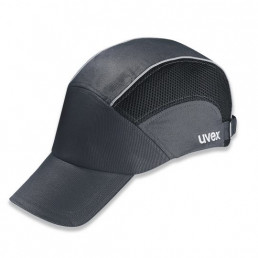Each year, around 60,000 work-related accidents involving head injuries are reported. For every 1,000 accidents reported, 1.5 of the head injuries are so serious that they result in death. Our skulls may be able to withstand a lot, but we should still ensure they are adequately protected especially when working in areas where there is a risk of falling objects and trip hazards. But when is a bump cap sufficient, and when do you need a helmet? Get to know the anatomy of your head in this blog post and find out everything you need to know about bump caps.
The anatomy of the head
Our head consists of a skull, which is a hard shell that protects our brain. The skull is made up of two parts: the neurocranium, which almost completely surrounds the brain, and the viscerocranium. The cerebrospinal fluid (liquor) acts as a shock absorber, cushioning the brain against impacts. Overall, our skull is made up of 20 individual bones. There are also delicate blood vessels and nerve pathways in the brain, which are connected to the rest of the body. That is why head injuries can also affect other parts of the body. The anatomy of the head already takes this into account, with the skull acting as a natural protective helmet – but there is no fixed definition of how much the skull can withstand. The skull’s resistance depends on the momentum, the period of force applied and the angle of impact. The position of the head also plays a role, because the skull is not equally strong throughout: The frontal bone is the strongest part of the skull, while the weakest bones are found in the temporal region. The skull can break from a pressure of 2–6 kp (20–60 N) per square millimetre – if it is on a fixed subsurface. When standing, the cervical spine compensates for the pressure, meaning that more force would be required in this case to suffer a fracture of the skull.

Head injuries
External bumps, splits, minor bruises or injuries on the head happen quickly – in around 9,800 work-related accidents each year, employees suffer open head wounds. But since these usually only concern the periosteum, they heal quickly and leave no further damage, other than a few scars. When the brain is involved, however, a head injury becomes really dangerous. Approx. 19% of all work-related accidents that involve a head injury result in a concussion.
A concussion occurs when the brain hits against the interior wall of the skull due to an impact – this could be the impact on the floor after a fall or an object impacting against the head. The significant shock causes the brain to suffer a temporary dysfunction – which is why we also speak of a traumatic brain injury. All head injuries in which the brain is injured or its function is disrupted, are called traumatic brain injuries. Each year, around 250,000 people are affected by this kind of trauma. But different severities and types are distinguished:
- Level 1: Mild traumatic brain injury 15 minutes loss of consciousness, no neurological consequences
- Level 2: Moderate traumatic brain injury Up to one hour loss of consciousness, potential delayed neurological consequences.
- Level 3: Severe traumatic brain injury Loss of consciousness for more than one hour, neurological consequential damage very likely.
To determine the severity, the bodily motor functions, verbal response capacity and the reaction of the eyes are assessed. This is done using the Glasgow Coma Scale (GCS Score) to assess the individual criteria – the higher the score, the less severe the injury. A contusion of the skull, for example, does not involve a traumatic brain injury, because in this case the brain remains uninjured and no dysfunction occurs. A concussion is a mild form of traumatic brain injury. Other frequently occurring head injuries include cerebral contusion, compression of the brain, skull fracture and basal skull fracture. Around 5% of head injuries are so severe that the person affected is permanently damaged and in need of care – in the worst case, a severe traumatic brain injury can cause death.

Head protection: Bump cap or helmet?
To protect yourself and your head against moderate to severe traumatic brain injury, it is vital that you wear head protection in certain work areas. Whether you are hit by falling, protruding, fixed or suspended objects, devices and machinery – you could soon suffer a head injury.
What is a bump cap?
A bump cap is a head covering in the form of a baseball cap. But it is not an accessory you wear to watch your favourite sport or as a style choice – because the bump cap is part of your personal protective equipment (PPE). A plastic insert in the cap protects the head against impacts. uvex bump caps have an injection moulded plastic shell, which also provides optimal protection for the back of the head.
But bump caps are no replacement for helmets, because a bump cap can only be worn in work areas where there is no helmet requirement. Because even if the risk assessment does not deem it necessary to wear a helmet, this does not mean that there is not still a risk to the head. You may still hit or graze your head against hard or protruding objects. Bump caps are intended to protect the wearer against exactly these types of accidents.
In contrast to the helmet, bump caps made of fabric are particularly comfortable to wear – in addition to the soft material, the light weight also ensures a comfortable fit. According to the requirements laid down in DIN EN 812 for industrial bump caps, they must be able to absorb impacts, be puncture-proof and ensure an optimal fit. Some bump cap models are also able to withstand extremely low temperatures of down to -30°C, flames and an alternating voltage of up to 440 V.

Bump caps are most often worn at assembly lines, in warehouses, when operating forklifts as well as in machinery and plant engineering. Many tradespeople, such as carpenters, joiners and painters, also wear these industrial caps during their work when there is no obligation to wear a helmet. Bump caps are also a favourite head protection in agriculture and abattoirs, as well as for railway or airport workers.
But when wearing a bump cap, never forget that they only have a low energy absorption capacity and therefore do not protect against falling objects or strong impacts. Therefore, you must never forget to wear a protective helmet on construction sites or in other areas with a high risk potential.
What do you and your employees wear? Bump cap or helmet? We’d love to hear about your work area and what kind of head protection is required there. Discover our extensive range of uvex bump caps. We are happy to provide detailed advice about our products. Read our blog post “Ergonomics is a matter for the head – long-term protection of head and face” for more interesting facts about head protection.
Sources:
https://publikationen.dguv.de/widgets/pdf/download/article/3893
https://www.kenhub.com/de/library/anatomie/anatomie-von-kopf-und-hals
https://www.suva.ch/de-ch/news/2018/schaedel-schuetzt-das-gehirn